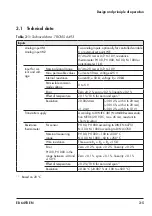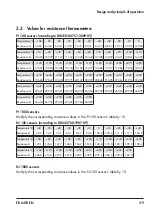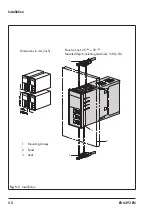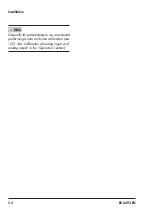
EB 6493 EN
3-1
Design and principle of operation
3 Design and principle of oper-
ation
The TROVIS 6493 Compact Controller is a
panel-mounted digital controller to automate
the industrial and process plants. It is suit-
able for control of continuous, on/off or
pulsing final control elements (e.g. electro-
pneumatic positioners, electric actuators,
heating systems, refrigerating machines etc.)
The controller is configured to adapt it to
control tasks. The controller settings are
saved in a non-volatile memory, even when
the power supply fails. It can be protected by
a key number.
Control modes
The compact controller is designed for fixed
set point and follow-up control. Two internal
set points and one input for the external set
point are available.
Default settings
The default compact controller is a tempera-
ture controller for fixed set point control with
the internal set point W that operates as a PI
controller.
The controlled variable is measured at the
analog input IN2 (Pt 100 resistance ther-
mometer).
The
4 to 20 mA control signal is issued at the
analog output Y.
Analog inputs
The analog inputs IN1 and IN2 can be ad-
justed to the following ranges:
−
0 to 20 mA, 4 to 20 mA, 0 to 10 V, 2 to
10 V
−
Pt 100, Pt 1000, Ni 100, Ni 1000 resis-
tance thermometers in three-wire circuits:
The resistance of each connection lead
must be the same and not exceed 15 Ω.
Resistance thermometers can also be
connected in two-wire circuits.
In two-wire circuits, take into account that the
lead resistance may reach several ohms over
long distances, causing the measured value
to be considerably distorted. This measured
value can be compensated for by a correc-
tion value (see '-CO- F.FOR Feedforward
control' in the Configuration Manual
u
−
Potentiometer 1 kΩ (resistance transmit-
ter) in three-wire circuit:
A potentiometer is used, for example for
position feedback of an electrical actua-
tor or for input of an external set point.
The controller is configured to assign an in-
put to the controlled variable
X
and the other
input to the input variable
WE
. The input
variable
WE
can be used as an external set
point, feedforward control input value (auxil-
iary controlled variable) or external position
feedback. The '-CO- F.FOR Feedforward
control' function allows two input variables
to be added or subtracted. For example, a
Note
Summary of Contents for Trovis 6493
Page 6: ...Contents EB 6493 EN...
Page 22: ...3 10 EB 6493 EN...
Page 30: ...5 6 EB 6493 EN...
Page 36: ...6 6 EB 6493 EN...
Page 72: ...8 12 EB 6493 EN...
Page 84: ...11 2 EB 6493 EN...
Page 86: ...12 2 EB 6493 EN...
Page 88: ...13 2 EB 6493 EN...
Page 90: ...14 2 EB 6493 EN...
Page 92: ...15 2 EB 6493 EN...
Page 95: ...EB 6493 EN 16 3 Certificates TR CU certificate...
Page 96: ...16 4 EB 6493 EN Certificates...
Page 97: ...EB 6493 EN 16 5 Certificates...
Page 98: ...16 6 EB 6493 EN...
Page 125: ......
Page 126: ......
Page 127: ......














































